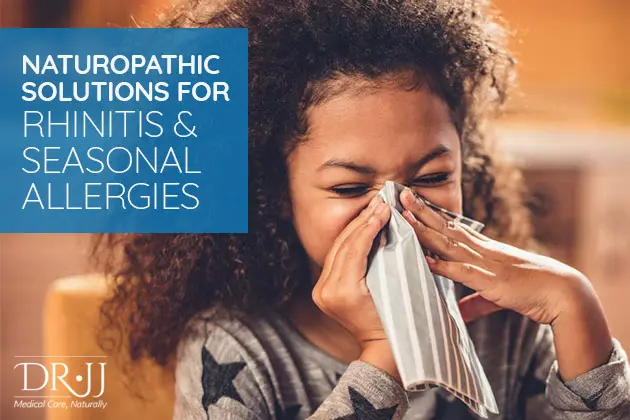
This is a great time of year to finally find a good naturopathic doctor in Toronto – right when allergy season is reaching its peak.
Many Canadians suffer from seasonal allergies, and many more from environmental allergies.
To help you figure out what is happening to your immune system and figure out your next steps, here’s some help.
What Is An Environmental Allergen?
An allergen is something that causes an allergic reaction to occur, but there are different types.
Environmental allergens are present in the environment year-round, whereas seasonal allergens are only a factor at certain times of the year.
The body produces an allergy response when it misinterprets a harmless substance as a threat, and goes on the warpath.
Most Common Plant-Based Environmental Allergens
Although there are several common NON-plant sources of environmental allergens, the most common of all are mostly plant-based.
1. Tree Pollen
Tree pollen is a powder that is usually dispersed into the air during the spring when trees are starting to blossom.
Unfortunately, that makes it difficult for tree pollen allergy sufferers to avoid it.
Symptoms include sneezing, congestion and a runny nose, sore throat and coughing, and watery eyes.
Tree allergy season usually hits in April and May.
2. Grass Pollen
Grass also produces pollen in the early spring, and it is very fine and difficult to see.
Grass pollen allergies produce symptoms such as itchy, watery eyes and a runny nose.
Grass allergy season follows right after tree season: in June and July.
3. Ragweed Pollen
Ragweed allergies are very common as a complaint source, which hits every year at the same time – between August and October.
Ragweed allergy symptoms can get quite severe, and include sinus pressure, scratchy throat, coughing and wheezing, itchy and/or watery eyes, decreased sense of smell or taste and poor sleep.
4. Mould
Mould grows in damp, dark places, especially where there is low airflow – the common places are in your garbage can or basement.
Mould spreads by sending spores airborne in order to find new breeding grounds, but that just makes it easy to inhale.
If you have ongoing exposure to mould spores, it could mean wheezing, runny nose, watery eyes and sometimes hives.
5. Other Sources
Other possible allergens you could be exposed to are dust mites, animal dander and cockroaches.
Animal dander, for instance, is caused when pets and other animals in your environment groom themselves – it is basically flakes of their dead skin.
Dust, similarly, is mostly comprised of minute human skin flakes, but it’s the dust mites that cause problems.
Mites live in your carpets, bedding or clothing, and they feed off the human skin dust; their waste is what causes your allergy symptoms.

Symptoms Of Environmental Allergies
Allergies are sometimes mistaken for a cold, because many of the symptoms are similar.
It’s the cause that’s different – colds are caused by viruses, whereas allergies are an immune response.
In general, the symptoms of environmental allergens look like a combination of the following:
• Watery eyes
• Headaches
• Wheezing
• Fatigue
• Itchiness of the skin or eyes
• Shortness of breath
• Sneezing
• Coughing
• Dry or sore throat
What Is Rhinitis?
Rhinitis describes a set of conditions related to the nose, most of which are caused by inflammation.
It is caused by a reaction – often allergies – that causes a runny and/or stuffy nose, sneezing and also itching.
Naturopathic Solutions For Seasonal Allergies
The most commonly-used escape from symptoms involves taking over-the-counter medication
However, this involves chemical-based pharmaceuticals that come with a whole host of side-effects, some of which are very uncomfortable.
Below are some options for addressing your allergies naturally.
1. Reduce Your Exposure To Allergens
It seems simple, and it works – by simply removing the allergens from your environment to the best of your ability will help to reduce the severity of your symptoms.
For instance, keep your windows closed to keep out the pollens, especially on high pollen count days.
If you have pets, try to at least keep them out of your bedroom – you’ll sleep better without them, and it’s good to have at least one room you can retreat to for relief.
As well, their dander can get ground into your bedding and soft bedroom furniture, so avoiding that issue is paramount for an allergy sufferer.
The last tip here is to try to wash your pets more often – both to reduce the dander and to clean them of any pollen they may have picked up while they were outside.
2. Eat Quercetin-Rich Foods
Quercitin is a bioflavonoid that will help your body to stabilize its release of histamines.
It helps to naturally control your allergy symptoms by calming your airways.
You can find quercetin in cruciferous veggies (such as cauliflower or broccoli), citrus fruits, green tea, and also onions and shallots.
However, it can take several months for the quercetin to start working, so be sure to eat these foods year-round, or at least start well before spring hits your neighbourhood.
3. Practice Good Hygiene
We mentioned washing your pets above – and the same goes for us humans.
Showering after you come in from outdoors can help remove the pollens and allergens.
Washing your clothes often enough helps to reduce your contact with pollens, mold spores and other allergens. That might mean making use of your washing machine more often than in the winter, but your nose will thank you for it.
4. Use An Air Filter
A good indoor air filter can help prevent allergens from entering your home or continually circulating through it.
This is a particularly good option for people with dust mite allergies, and it can be achieved with an air purifier that includes a HEPA filter (which stands for “high-efficiency particulate air”).
If you’re particularly prone to allergies or severe symptoms, you may also want to buy a vacuum with a HEPA filter included.
5. Increase Your Intake Of Probiotics
Probiotic-rich foods are a great way to help with allergies, because they are anti-inflammatory, which really helps some of the allergen responses.
Probiotic foods include kimchi, kombucha, sauerkraut, miso, kefir, yogurt, natto and raw cheese.
One surprising source is breast milk, which helps babies to remain immune to seasonal allergies.
Questions? Ask Dr. JJ!
In case this article lead to more questions, feel free to reach out to me, Dr. JJ, and I’ll be happy to answer your questions.
In fact, if you can call now to book a consultation with me, we can work to get you prepared for allergy season, so it doesn’t hit you as hard as usual.
If you have questions about naturopathic medicine, or you’d like to take your first step into the world of naturopathy, contact me, Dr. JJ, and let’s book an appointment.
Yours in health,
Dr. JJ Dugoua, Naturopathic Doctor
600 Sherbourne St, Suite 315,
Toronto, ON M4X 1W4
-https://goo.gl/maps/6VDXwiCihRpDRo5A9
Dr. JJ Dugoua is a naturopathic doctor in Toronto and has a PhD in Pharmaceutical Sciences. His clinic provides solutions for many health concerns and has a special focus on thyroid health issues.


